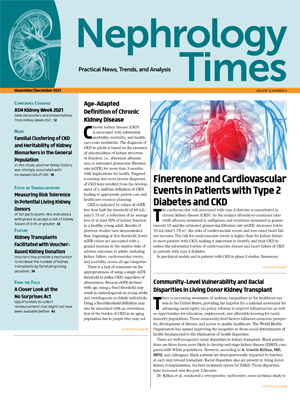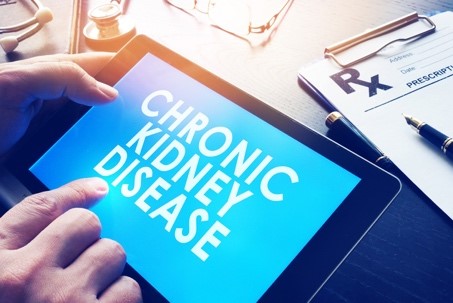
Major organizations have issued guidelines for the treatment and management of kidney cancer that favor nephron-sparing approaches such as partial nephrectomy or ablation, or active surveillance in patients with small kidney masses. According to Jeffrey M. Howard, MD, and colleagues, awareness of the undertreatment of clinically aggressive cancers, particularly among underserved racial/ethnic groups and those who are uninsured or underinsured, is increasing. There are few data available on the association between patient demographic characteristics and clinical decision making in kidney cancer care.
The researchers conducted a retrospective cohort study to examine the association between demographic factors that included sex, race/ethnicity, and insurance status, and receipt of non-guideline-based care for kidney cancer. Results of the study were reported online in JAMA Network Open [doi:10.10.1001/jamanetworkopen.2021.12813].
The primary outcome of interest was receipt of non-guideline-based treatment, undertreatment or overtreatment, for kidney cancer as defined by accepted clinical guidelines. The researchers utilized data from the National Cancer Database (NCDB), a joint project of the Commission on Cancer (CoC) of the American College of Surgeons and the American Cancer Society. The database includes data from more than 1500 CoC-accredited hospitals in the United States and includes ~70% of all new cancer diagnoses in the United States.
The database contained 339,641 patients with a primary diagnosis of kidney cancer (International Statistical Classification of Diseases and Related Health Problems, Tenth Revision site code c64.9) from January 1, 2010, to December 31, 2017. The dates coincided with the implementation of the 2009 American Urological Association guideline on management of small kidney masses.
Following application of inclusion and exclusion criteria, the final study population included 158,445 patients with CT1-2, NO, MO kidney cancer. Cancer staging was done according to the seventh edition of the American Joint Committee on Cancer TNM system. The definition of guideline-based treatment was derived from the National Comprehensive Cancer Network clinical practice guideline version 1.2021 that incorporates tumor size and clinical stage: surveillance or nephron-sparing approaches such as ablation or partial nephrectomy are favored to treat smaller noninvasive masses; radical nephrectomy is favored in larger masses.
The study population was selected to represent a comparatively young and healthy cohort, making advanced age and comorbidity unlikely to be taken into consideration in treatment decision making. Median age of the cohort was 58 years, 62.8% were men (n=99,563), 75.7% were White (n=120,001), and 57.6% had private insurance (n=91,218). A total of 36,773 (23.2%) had a Charlson Comorbidity Index (CCI) score of 0 and 121,721 (76.8%) had a CCI score of 1. Guideline-based treatment was provided to 69.4% of the cohort (n=109,901); 30.6% (n=48,544) received non-guideline-based treatment. Of the group that received non-guideline-based treatment, 3893 (2.5%) patients were undertreated and 44,651 (28.2%) were overtreated. Over the study period, the total number of patients increased, as did the proportion of patients receiving guideline-based treatment, from 11,206 of 16,934 (66.2%) in 2010 to 15,055 of 21,126 patients (71.3%) in 2017 (P<.001).
Results of multinominal logistic regression analyses demonstrated that in the overall study population, women were treated more aggressively than men, with statistically lower adjusted odds of undertreatment (odds ratio [OR], 0.82; 95% confidence interval [CI], 0.77-0.88; P<.001) and statistically significant higher odds of overtreatment (OR, 1.27; 95% CI, 1.24-1.30; P<.001), controlling for other demographic factors.
In subgroup analysis, the association between female sex and overtreatment was preserved for small (<2 cm) cT1a kidney masses (OR, 1.15; 95% CI, 1.06-1.24; P<.001) and large (2-4 cm) cT1a kidney masses (OR, 1.13; 95% CI, 1.05-1.21; P<.001). Women had statistically significant lower adjusted odds of undertreatment for cT1b tumors (OR, 0.79; 95% CI, 0.73-0.86; P<.001). There was no statistically significant association for cT2 tumors.
There were associations between Black race and statistically significant higher adjusted odds of undertreatment (OR, 1.42; 95% CI, 1.29-1.55, P<.001) and overtreatment (OR, 1.09; 95% CI, 1.05-1.13; P<.001) compared with White race, controlling for other demographic factors. The association between Black race and undertreatment remained statistically significant in subgroup analysis for cT1b and cT2 kidney masses. In the subgroup of patients with smaller masses, the adjusted odds of overtreatment were statistically significantly lower for patients with small cT1a masses.
There was an association between Hispanic ethnicity and undertreatment (OR, 1.20; 95% CI, 1.06-1.36; P=.004) and overtreatment (OR, 1.06; 95% CI, 1.01-1.11; P=.01) in the primary analysis. In subgroup analysis, the association was significant in only some tumor classifications.
There was a significant association between uninsured status and receiving less aggressive treatment when compared with private insurance status. Being uninsured was statistically significantly associated with higher adjusted odds of undertreatment (OR, 2.63; 95% CI, 2.29-3.01; P<.001) and lower adjusted odds of overtreatment (OR, 0.72; 95% CI, 0.67-0.77; P<.001). The associations remained significant in subgroup analysis for overtreatment of small cT1a masses (OR, 0.40; 95% CI, 0.33-0.49; P<.001) and undertreatment of cT1b masses (OR, 2.49; 95% CI, 2.10-.294; P<.001) and cT2 masses (OR, 2.77; 95% CI, 2.11-3.62; P<.001). The association for overtreatment of large cT1a masses was not statistically significant (OR, 1.01; 95% CI, 0.91-1.11; P=.92). The pattern was similar for patients with Medicaid insurance.
The authors noted some limitations to the study findings, including retrospectively applying a contemporary guideline to patients treated in the past and the use of the NCDB that represents a nonrandom subset of the overall US population.
In summary, the researchers said, “To our knowledge, this study represents the first attempt to assess the associations between demographic factors and receipt of non-guideline-based treatment among patients with kidney cancer. We found that female patients with kidney cancer had higher odds of receiving more aggressive treatment than men, which was associated with increased rates of overtreatment for small kidney masses and potentially increased risk for unjustified complications. Black race and Hispanic ethnicity were associated with higher odds of undertreatment and overtreatment, highlighting the bidirectional nature of inequities in treatment. Patients without insurance had markedly lower odds of overtreatment for very small kidney masses, potentially representing a rare example of a salutary association of reduced access to care. Clinicians should bear these disparities in mind when counseling individual patients, and health policy makers should take the existence of these disparities into account.”
Takeaway Points
- A retrospective cohort study was designed to determine whether demographic factors, including sex, race/ethnicity, and insurance status, are associated with receipt of non-guideline-based treatment for kidney cancer.
- In a cohort of patients identified using data from the National Cancer Database for the period 2010 through 2017, women were treated more aggressively than men, with lower odds of undertreatment and higher odds of overtreatment.
- Black and Hispanic patients had higher adjusted odds of undertreatment and overtreatment compared with White patients. There was an association between uninsured status and lower adjusted odds of overtreatment and higher adjusted odds of undertreatment.







 © 2025 Mashup Media, LLC, a Formedics Property. All Rights Reserved.
© 2025 Mashup Media, LLC, a Formedics Property. All Rights Reserved.